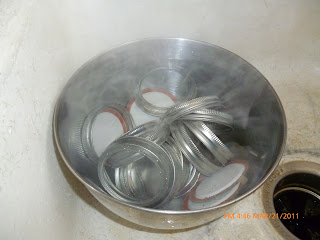Lard is what you have after cooking down the fat from a pig. Some dear friends of ours raised a pig for us over the winter. They live on a small farm about an hour north of us. When I called my cutting order in when the pig was butchered, I asked them to bag up the leftover fat. I got about fifteen pounds of fat. It takes a little over a pound of fat to make a pint of lard.
Here is the fat:
I used half of this fat and stored the other half in the freezer.
First I cut the fat into roughly one inch cubes:
I then put all of the cut up piggy fat into my biggest cast iron kettle:
I added one cup of water to help prevent scotching, turned the flame to medium, and waited and watched. After about an hour I could see the fat beginning to turn a pale brown and start to render:
Another hour:
After another hour of watching, waiting, and stirring, with an adorable baby on my hip:
It looked like this:
When I do this again, I will stop here and call it done. Everything I read said to wait until the cracklings (those hunks of brown fat you see there on the top) sink to the bottom. When they began to sink:
I thought it looked like it was beginning to scorch, and it smelled vaguely of burnt bacon. I cooked it down a bit too long. Live and learn, right? While I drained the cracklings from the lard:
I prepared my canning jars. I put the rings and lids in a stainless steel bowl and poured boiling water from the tea kettle over them:
I did the same thing with the jars, then setting them on a rack to cool:
I then poured the rendered lard into the jars and capped them tightly. The heat from the lard was enough for them to seal on their own.
We wanted to keep the cracklings for cornbread, but they were just too well done. I then washed the dishes and had a glass of wine:
And in the morning, we had eight pints of freshly rendered lard!















This is great. I use a lot of lard but buy it locally. Definitely going to have to try this!
ReplyDeleteI have always heard that rendering lard smells-is this true? My husband would love it if I could get a hold of lard for him, I may just have to try this!
ReplyDeleteVery interesting post. I always wondered how to make lard.
ReplyDeleteMany years ago, a friend of my father's gave us some fresh lard from his annual cow and pig "harvest." It made the most wonderful, flaky pie crust I have ever eaten.
One word for the pics in this post....EW! I understand the purpose, but...EW!
ReplyDelete